[vc_row][vc_column][vc_column_text]When it comes to making fresh pasta at home, there are a few basic tools you’ll need in your kitchen arsenal.
Can you make pasta without these items? Sure, you could do without (and if that’s your style, we tip our hats to you). But if you’re getting serious about pasta making, all we can say is this: these tools are workhorses, and are going to quickly become your best friends come pasta time.
And just in case you don’t believe us, we invite you to watch any one of the Pasta Grannies videos. You’ll likely spot an Italian nonna rolling out her dough using some version of these gadgets![/vc_column_text][vc_empty_space][vc_column_text]
One of the best ways to cut out fresh egg pasta is to use a rotella per la pasta, or pasta wheel. Think: a mini pizza cutter. Using a wheel instead of a knife allows you to cut a straight edge in one swift movement. Plus, many pasta wheels also come with decorative fluted edges or have multiple wheels making it easier to cut out ribbons or squares all at once.
What shapes can you make with a pasta wheel? A single wheel will allow you to cut out lasagne, mafaldine, pappardelle, and more. With a multi-wheel pasta cutter, you can create squares and rectangles to serve as the base for just about any stuffed pasta shape, from tortellini to ravioli. If you have a fluted wheel, you can add a decorative zig-zag edge to just about any shape! It’s especially great for farfalle.
Pasta Roller. You can roll out egg pasta dough by hand with a rolling pin, but unless you have years of practice and muscle memory, you’ll want to use a machine to help you. … Pastry Wheel. … Biscuit Cutters. … Gnocchi Board. … Bench Scraper. … Semolina Flour.
-
Pasta Roller. You can roll out egg pasta dough by hand with a rolling pin, but unless you have years of practice and muscle memory, you’ll want to use a machine to help you. …
-
Pastry Wheel. …
-
Biscuit Cutters. …
-
Gnocchi Board. …
-
Bench Scraper. …
-
Semolina Flour.

Wooden Pastry Board
Although marble and granite countertops make for gorgeous pasta pics, those kinds of surfaces aren’t ideal for making fresh pasta (but we still envy you if your kitchen has these!). Instead, a large untreated wooden pastry board is ideal for a few good reasons.
Ever watched a nonna roll out pasta? You’ll notice that she almost always does it on a wooden surface. This isn’t for the “rustic look.” It’s because the warmth and the grain of the wood impart a special texture on pasta.
While a regular cutting board will work in a pinch, we don’t recommend it for regular pasta-making use since it can sometimes hold unwanted residues from other foods that can seep into your pasta. Also, the incisions caused by knife cutting leave “scars” on cutting boards board where pasta dough can creep into. Our rule of thumb: keep your pasta on a pasta board and your meat and veggies on their own respective cutting surfaces!
And finally, having a separate wooden board that you can move around gives you much more flexibility in the kitchen. This is particularly helpful if you have a small kitchen where every inch of counter space counts. You make your pasta on your wooden board, then shift the whole thing to the dining table, freeing up counter space to prep your sauce!
We particularly love our reversible maple wooden pastry board. You don’t even need to use soap and water to clean this – untreated wood can be cleaned with a simple, hearty scrape to remove any flour that’s caked onto the surface. If you must, we’ve heard from an Italian mother or two that a simple scrub with baking soda, water, and a bit of lemon rind is a natural way to clean your board and rid it of any odor.[/vc_column_text][vc_empty_space]
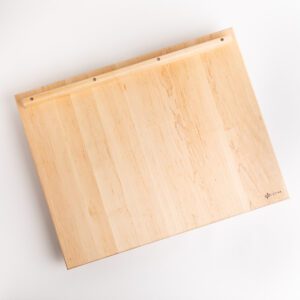
Ridged Gnocchi Board
Good pasta is all about the texture! Adding ridges and grooves to the surface area of your pasta not only adds a beautiful look to your noodles but also creates highly functionally, sauce-capturing crannies.
An easy way to achieve this kind of texture is using a gnocchi board. With this simple tool, you can make homemade gnocchi, cavatelli, garganelli, and more! A gnocchi board is an affordable tool that’s perfect for even the most beginner pasta makers, especially because shapes like gnocchi and cavatelli rely on very little other special equipment.[/vc_column_text][vc_empty_space]
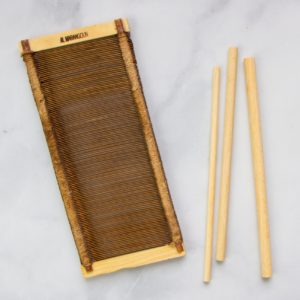
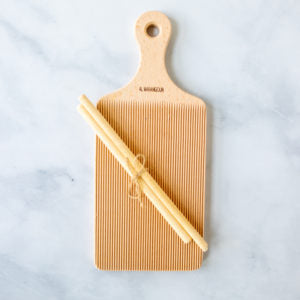
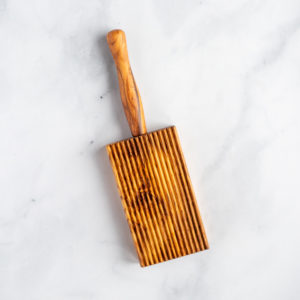
When making pasta, things can get messy: dough can stick to your work surface and flour may go all over the place. But with a sturdy bench scraper, you can scoop things into place in one fell swoop. And if dough starts sticking to your board, all you have to do is scrape it off with the scraper.
Bench scrapers also come in handy when you’re cutting dough into smaller pieces. Although you could also use a knife for this, we find that a pastry scraper is slightly more comfortable and effective at getting a clean cut.
Having a bench scraper is especially important for keeping your wooden surface clean! We can’t stress this enough: it’s imperative to scrape off any leftover dried bits of dough throughout the pasta-making process to prevent them from getting into your soft and smooth dough. Those dried bits can cause the dough to tear when rolling it out and leave an unwanted texture.
We love our half-moon pasta bench scraper, which also functions as a ruler! It’s great for keeping a consistent cut size on certain pasta shapes.[/vc_column_text][vc_empty_space]
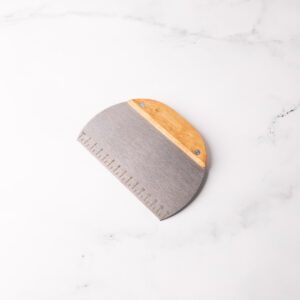
8 Essential Tools for Making Homemade Pasta Like a True Italian
FAQ
What equipment is needed for pasta?
What materials are needed for pasta?
What is the machine used to make pasta?
What are the best tools and equipment for making pasta?
This article lists the best tools and equipment for making pasta. Of course, the basics: a pasta machine, pasta cutters and rollers, a drying rack.. but what else do you need to complete your pasta toolset? Some of the tools in this list really are must haves – especially the pasta maker and the pasta cutter.
Can one eat pasta?
Pasta can be part of a diet, but in moderate amounts (100g of dried pasta daily), and it is better when it is made from whole grains rather than refined. Also, you must also have it combined with vegetables. Avoid taken it with fatty foods such as cream and cheese.
What equipment do I need to make a pasta sfoglia?
So, “essential” is really specific to exactly the type of shapes you want to make. If you are making just about anything out of egg dough, you need a good rolling pin (or a special pasta mattarello) and/or a pasta maker so you can get a properly thin, even sfoglia (a sheet of rolled out pasta dough).
What do you need to make pasta?
Pasta is sublime in its simplicity: you truly need nothing more than flour, water, and your own hands. But just because it can be that minimalistic doesn’t mean it needs to be. There is a deep, exquisite rabbit hole you can go down exploring pasta-making tools.
